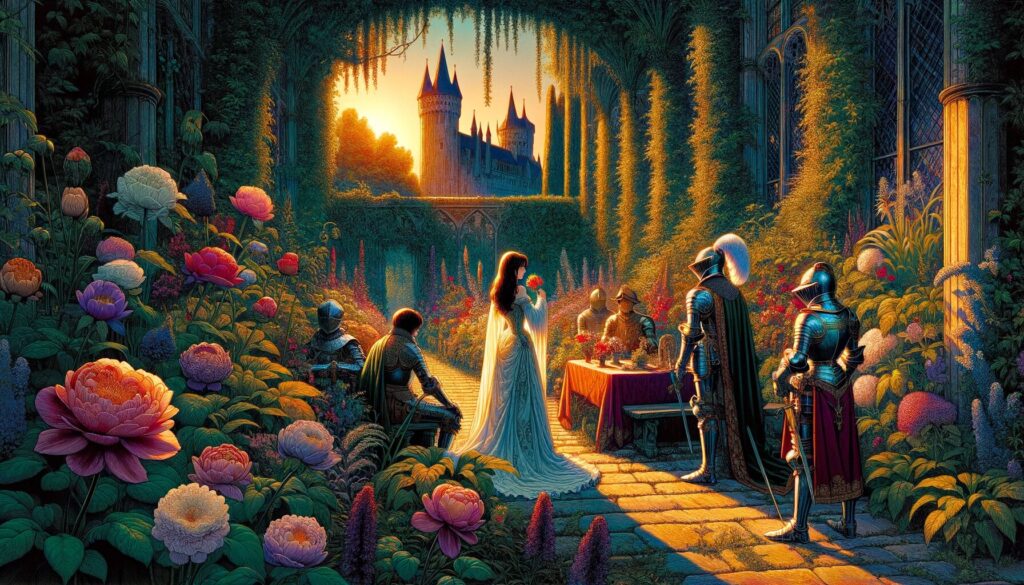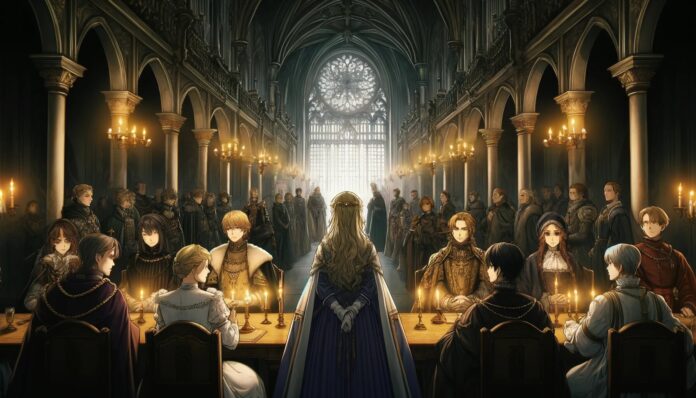The opening of our exploration into “The Flower of Veneration Chapter 1” develops the stage for a deep dive into a world where political intrigue and personal ambition collide. This narrative begins with the sudden and mysterious death of a Duke, an event that not only serves as a crucial plot catalyst but also introduces us to a complex web of characters and themes.
As we unpack the layers of this compelling first chapter, we will explore the intricate dynamics of power, the subtle interplay of loyalty and betrayal, and the profound symbolism embedded in the story’s setting and character interactions. Join us as we dissect how these elements converge to craft a narrative that is as much about the human condition as it is about the allure of mystery and politics.
Mysterious Death of the Duke
The dramatic demise of the Duke serves not just as the opening scene but as the linchpin for the entire narrative of “The Flower of Veneration Chapter 1” This event triggers a series of repercussions that ripple through the lives of the characters and the structure of the kingdom itself.
As a narrative device, the Duke’s death is masterfully utilized to capture the reader’s attention and set a tone of suspense and intrigue. This incident raises immediate questions about succession, the stability of the realm, and the undercurrents of power that flow through the aristocracy.
Analyzing this moment, we delve into how the author crafts a mystery that does more than propel the plot; it invites the reader into a detective role, piecing together clues that are sprinkled throughout the chapter and speculating on the political and personal ramifications of this significant loss.
Cecilia and the Two Knights
In the wake of the Duke’s unexpected death, we are introduced to the primary characters whose decisions and development will drive the narrative. Cecilia, the Duke’s daughter and presumed heir, emerges as a central figure grappling with her new role under the shadow of her father’s legacy.
Alongside Cecilia, two knights appear, each embodying different facets of loyalty and honor. This section examines how the author uses these introductions to not only advance the story but also to deepen our understanding of the political and emotional landscape. The characters are crafted with complexities that reflect broader themes of duty, ambition, and the human struggle for power and recognition.
By analyzing their roles, we explore how they contribute to the story’s tension and dynamics, setting up expectations for their future paths and challenges.
Political Tensions and Alliances
The political landscape of “The Flower of Veneration Chapter 1” is a tapestry woven with threads of alliance, betrayal, and ambition. The Duke’s death unveils a fragile network of relationships and a power vacuum that threatens the stability of the realm.
This section focuses on how the setting is not merely a backdrop but a character in its own right, influencing and reflecting the characters’ actions and decisions. We explore the intricacies of the political machinations that begin to unfold, examining how the author sets up a chessboard of noble houses, each with their agendas and secrets.
The political tension not only adds depth to the plot but also serves as a mirror to real-world political games, where power is both a prize and a peril.

Exploring Character Motivations and Ambitions
Understanding the motivations that drive the characters of “The Flower of Veneration Chapter 1” provides key insights into the narrative’s depth and the complexity of its plot. In this extensive analysis, we delve into Cecilia’s psyche as she navigates the turbulent waters of leadership, the loyalty and conflicts of the two knights, and the broader implications of their actions in the realm.
Each character is meticulously crafted with motivations that are deeply intertwined with their personal histories and the political landscape they inhabit. This exploration not only highlights skillful character development but also examines how these motivations influence the unfolding drama and the strategic decisions made in the shadows of power.
Themes of Power and Legacy
Power and legacy are central themes that pulse through the heart of “The Flower of Veneration Chapter 1” This section provides a thorough analysis of how these themes are explored through the narrative’s major and minor events. The struggle for power following the Duke’s demise and the burden of legacy borne by Cecilia are dissected to reveal how they affect character behavior and plot progression.
We consider the historical and cultural parallels the story draws, exploring how the themes of power and legacy resonate across different epochs and societies. This discussion extends beyond the confines of the narrative to touch on universal questions about the nature of power—its allure, its transient nature, and its ability to shape destinies.
The Significance of the Enigmatic Flower
The symbolic use of the flower in “The Flower of Veneration” is pivotal in understanding the deeper narrative layers that the author weaves into the fabric of the story. This section delves into how the flower represents various thematic elements, such as beauty, fragility, and resilience, paralleling Cecilia’s journey through the tumultuous realm of leadership and legacy.
We explore the dual nature of the flower, both as a symbol of the potential for growth and the inevitability of decay. By examining the recurrent imagery of the flower throughout the chapter, we discuss how it reflects the characters’ vulnerabilities and strengths, serving as a metaphor for the political and personal landscapes they navigate.
This analysis extends to how the flower’s symbolism enriches the reader’s understanding of the story, adding layers of meaning that underscore the narrative’s complexity and thematic richness.
The Role of the Garden
The garden where the Duke is found dead is not just a physical setting but a symbolic microcosm of the kingdom itself. This section analyzes how the garden’s serene yet secretive nature mirrors the deceptive calm of the kingdom’s political climate.
We dissect how the garden’s features—its enclosed walls, the carefully curated flora, and the hidden nooks—parallel the constructed appearances and hidden agendas within the royal court.
The garden, as a setting for the Duke’s mysterious death, symbolizes the undercurrents of danger and intrigue that lurk beneath the surface of noble life.
Through a detailed examination of the descriptions and roles of the garden, we reflect on its importance in setting the tone for the narrative and foreshadowing future conflicts, making it a crucial element in the unfolding drama.

Cecilia’s Journey From Grief to Leadership
Cecilia’s transformation from a grieving daughter to a leader in a male-dominated society is a compelling narrative arc that spans “The Flower of Veneration Chapter 1.” This section provides a deep dive into Cecilia’s emotional and psychological journey, examining how her grief serves as both an obstacle and a catalyst in her ascension to power.
We explore the challenges she faces, from external pressures of nobility to internal conflicts about her identity and capabilities. This analysis highlights the complex interplay of personal growth and leadership demands, discussing how Cecilia’s development is portrayed through her interactions, decisions, and the evolving dynamics with other characters.
By focusing on Cecilia’s journey, we illustrate the broader themes of power and inheritance, showcasing how her personal story reflects larger societal and thematic concerns.
The Dual Roles of the Knights
The two knights introduced in the chapter are not merely protectors of Cecilia but also significant players in the political games that ensue. This section examines the multifaceted roles of these knights, analyzing how their loyalty and ambitions impact the storyline and Cecilia’s fate.
We explore their backgrounds, motivations, and the complex moral dilemmas they face, which highlight the broader themes of loyalty and betrayal. By dissecting their actions and decisions, we discuss how they act as both guardians and potential threats, influencing the power dynamics within the story.
This comprehensive analysis reveals how the knights’ dual roles contribute to the narrative’s tension and complexity, offering wisdom into the complex web of connections that define the kingdom’s politics.
Building Suspense and Intrigue
The author of “The Flower of Veneration Chapter 1” operates a field of literary devices to enhance the narrative’s suspense and engage the reader. This section explores the techniques used, such as foreshadowing, pacing, and the strategic placement of red herrings, to weave a tapestry of mystery and tension.
We analyze how these devices are integrated into the narrative structure, enhancing the storytelling by keeping the reader invested and on edge.
Through specific examples from the text, we illustrate how the author skillfully manipulates narrative elements to craft a compelling story that not only entertains but also invites deeper analytical engagement.
This discussion extends to the effects of these techniques on the reader’s experience, emphasizing their role in shaping the narrative’s effectiveness and appeal.
These in-depth analyses of each segment of the chapter provide:
- A comprehensive understanding of “The Flower of Veneration Chapter 1.”
- Showcasing the intricacies of its plot.
- Character development.
- Thematic exploration.
By dissecting these elements, the article highlights the richness of the narrative and offers a critical lens through which readers can appreciate its complexity and craftsmanship.
Cultural and Societal Reflections in the Narrative
The narrative of “The Flower of Veneration Chapter 1” reflects and critiques a myriad of cultural and societal structures, mirroring real-world dynamics within its fictional setting. This section delves into how the author incorporates cultural nuances and societal hierarchies into the fabric of the story, highlighting themes of class, gender, and power.
We explore the depiction of the social order, from the nobility to the commoners, and how these layers interact and influence the unfolding political drama.
By examining the societal expectations placed on Cecilia as a female heir and the cultural rituals surrounding leadership and death, we discuss how these elements enrich the narrative and provoke thought on issues such as gender roles and social mobility.
This analysis extends to how the story serves as a commentary on historical and contemporary issues, providing a platform for discussing broader societal challenges through the lens of fiction.
The Role of Mystery and Detective Work
“Chapter 1 of The Flower of Veneration” masterfully engages readers by immersing them in a role akin to that of a detective, unraveling mysteries and piecing together clues. This section examines how the author crafts an interactive reading experience through the use of suspense, mystery, and strategic information revelation.
We discuss how the narrative encourages readers to speculate on the Duke’s death and the potential culprits, fostering an active engagement that extends beyond passive consumption. By exploring the clues laid out by the author and the questions raised, we analyze how this approach not only maintains reader interest but also deepens their investment in the story.
This engagement technique enhances the overall narrative impact, drawing readers into a deeper, more personalized connection with the unfolding events.
Foreshadowing Future Conflicts and Revelations
The use of foreshadowing in “The Flower of Veneration Chapter 1” is a key narrative strategy that sets the stage for future developments. This section focuses on how the author plants seeds of forthcoming conflicts and character evolutions in the first chapter, preparing the ground for complex plot twists.
We analyze specific instances where subtle hints are given about character loyalties, potential betrayals, and hidden agendas.
By discussing how these elements are interwoven into the dialogue, setting descriptions, and character actions, we reveal how foreshadowing not only builds anticipation but also layers the narrative with a richness that invites repeated readings.
This exploration shows how foreshadowing enriches the storyline, making each progression feel both inevitable and surprising.

The Impact of Setting on the Story’s Dynamics
The setting in “The Flower of Veneration Chapter 1” plays a crucial role in shaping the narrative’s dynamics and themes. This section explores how the physical locations, from the dark corridors of the castle to the lush yet secretive garden, contribute to the story’s mood and thematic undertones.
We discuss how these settings are not just backdrops but active elements in the story that influence character decisions and plot developments.
By examining the symbolism of these locations and their correlation with the narrative’s key events, we illustrate how the setting enhances the psychological and thematic depth of the story.
This analysis extends to how the author uses atmospheric details to create a sense of foreboding and intrigue, further drawing readers into the world of the story.
Conclusion
In concluding our analysis of “The Flower of Veneration Chapter 1,” we reflect on the intricate tapestry of narrative elements that combine to form a compelling opening to a saga of mystery and political intrigue.
Through the detailed dissection of themes, character development, and literary techniques, we have uncovered how the chapter not only sets the stage for a complex story but also engages deeply with themes of power, identity, and human ambition.
The chapter’s rich narrative structure, imbued with cultural and symbolic depth, invites readers to not only follow the plot but also engage with the text on a deeper level, challenging them to ponder broader existential and societal questions.
As we anticipate the next chapters, it’s clear that the journey through “The Flower of Veneration Chapter 1” promises to be as enriching as it is thrilling, offering readers a blend of thoughtful analysis and dramatic storytelling.
FAQ’s
What is the premise of “The Flower of Veneration Chapter 1”?
“The Flower of Veneration” is a narrative set in a mysterious and politically charged kingdom. It centers on Cecilia, who must navigate the complexities of power and inheritance after her father, the Duke, unexpectedly dies.
Who are the central figures in the story?
The main characters include:
- Cecilia, the daughter of the Duke, is thrust into leadership.
- Two knights, each with their loyalties and secrets, who serve as her protectors.
- A cast of nobles and advisors, all intertwined in the kingdom’s political schemes.
Why is the flower a significant symbol in the story?
The flower in the story symbolizes beauty, resilience, and the concealment of deeper secrets, mirroring the complexities and challenges the characters face as they maneuver through the political and personal landscapes of the kingdom.
Is “The Flower of Veneration Chapter 1” appropriate for all readers?
While the story is generally suitable for a broad audience, it includes themes and scenarios that may be better appreciated by older readers, particularly those interested in narratives of mystery, adventure, and political intrigue.
How many chapters are planned for “The Flower of Veneration Chapter 1”?
“The Flower of Veneration” is envisioned as a series, with additional chapters to be released that will continue to delve into Cecilia’s journey and the broader political and personal conflicts within the kingdom.
What themes are explored in “The Flower of Veneration”?
The story explores themes of power, inheritance, loyalty, and betrayal, all within a framework that examines personal growth against a backdrop of societal expectations and political maneuvering.
Can “The Flower of Veneration” be classified as a fantasy novel?
Yes, with its setting in a fictional kingdom and the inclusion of elements like mysterious flowers and political intrigue, it aligns well with the fantasy genre. However, it also incorporates features typical of mystery and drama.



